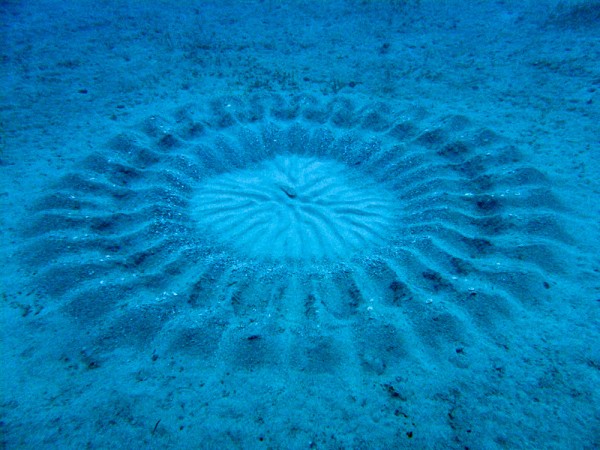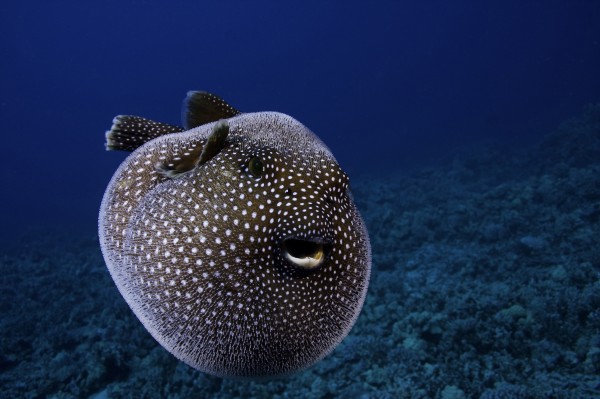What’s a Pufferfish? Explaining Animal Behind Mystery Circles
Mystery circles on the seafloor have intrigued divers for decades, and scientists recently identified the culprit: a new species of pufferfish.
This tiny architect—which builds elaborate nests to woo females—has also captured the hearts of our readers, with more than 60 comments and 30,000 Facebook likes on our story about the phenomenon. So we wondered: What’s a pufferfish?
A male pufferfish (center) made this nest to lure females in Japan in 2012.
It turns out there are 120 pufferfish species in the Tetraodontidae family. The fish live in warm, coastal waters around the world, and some even live in fresh water. They tend to have tapered, torpedo-shaped bodies with bulbous heads and large eyes.
Pufferfish have four large teeth that are fused together to form a beak-like structure. While some species of pufferfish use their beaks to scrape algae off rocks and coral, certain large species use their beaks to crack open crustaceans and shellfish.
They also come in a variety of colors and sizes, from the 1-inch-long (2.5-centimeter-long) pygmy puffer to the giant freshwater puffer, which can reach 2 feet (0.6 meter) in length.
Puffer Upper
Pufferfish are best known for their ability to “puff up” into a ball several times their normal size. Scientists think the fish developed this defense to compensate for their slow, clumsy swimming style.
A pufferfish might look like an easy meal to a predator, but if pursued, it will quickly fill its extremely elastic stomach with large amounts of water, making itself much bigger and nearly spherical in shape (below).
A guineafowl pufferfish swims in Hawaiian waters. Photograph by David Fleetham, Corbis
Most species are also covered with small spines that only stick out when they are inflated. A predator that doesn’t heed the pufferfish’s warning may be in danger of choking to death on the spiky, spherical fish. (Watch a video of pufferfish inflating to escape prey.)
But the pufferfish’s defenses don’t stop there: Many species are highly poisonous. Certain pufferfish contain the neurotoxin tetrodotoxin, mostly concentrated in the fish’s liver, gonads, and skin. Although this potent toxin can kill some predators (including people), others, such as sharks, are able to withstand a pufferfish meal with no ill effects.
Dangerous Delicacy
Despite the risks of ingesting tetrodotoxin, pufferfish are a delicacy in many parts of the world.
In Japan, only trained and licensed chefs may prepare pufferfish, known as fugu. Young chefs spend years learning how to properly prepare fugu, making sure that it is free of the toxic liver, gonads, and skin. Even with these precautions, several people die each year after ingesting improperly prepared fugu dishes.
Symptoms of tetrodotoxin poisoning begin with numbness in the tongue and lips, followed by headache, dizziness, and vomiting. In the worst cases, sufferers experience rapid heart rate, decreased blood pressure, muscle paralysis, and respiratory distress. Death can occur within four to six hours. The toxin typically kills by paralyzing diaphragm muscles and causing respiratory failure.
Not all pufferfish are toxic, and some species are easier to prepare safely. To keep U.S. consumers safe, the Food and Drug Administration has teamed up with scientists at the Smithsonian’s National Museum of Natural History to create a library of pufferfish DNA. When a tetrodotoxin poisoning occurs, officials can use the library to identify the species of pufferfish that was consumed and determine whether it was illegally imported.
Zombie Fish
The pufferfish’s tetrodotoxin is so powerful that some believe it even has the power to create real-life zombies.
In the 1980s, ethnobotanist Wade Davis—now a National Geographic Society Explorer in Residence—traveled to Haiti to investigate reports of zombification. During his research, Davis discovered that the voodoo sorcerers believed to be capable of turning people into zombies used homemade powders in their rituals. Davis collected and tested samples of zombie powders and discovered they contained pufferfish tetrodotoxin.
Pufferfish tetrodotoxin works in part by preventing neurons from firing. People who ingest the toxin and don’t die within the first 24 hours typically survive, although they often fall into a coma-like state for several days.
Completely paralyzed but fully conscious, the victims are pronounced dead and buried. After a few days, the voodoo sorcerer returns and claims the body, which then seems to rise from the dead.
Tell us: What’s your favorite thing about pufferfish?(Posted by Mary Bates in Weird & Wild on August 21, 2013)













